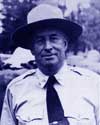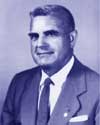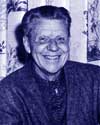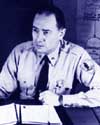MENU
Recommendations for
Further Reading
Parks and People
Evolution of a National Park Concept
Wildiands Designated...But Vulnerable
|
National Park Service: The First 75 Years
Revising the Mission |

|
Parks and People:
Preserving Our Past For The Future
by Barry Mackintosh

CCC workers constructing Leigh Lake
turnout, Grant Teton National Park, August 1933.
Revising the Mission
Dr. Harold Bryant.
(biography)Along with the influx of parks, the Service received another mission as Roosevelt launched his New Deal: helping to relieve the Great Depression then gripping the nation. Under Service supervision, the Civilian Conservation Corps (CCC) would employ thousands of jobless young men in a wide range of conservation, rehabilitation, and construction projects in both the national and state parks. At the program's peak in 1935, the Service over saw 600 CCC camps, 118 of them in national parklands and 482 in state parks, staffed by some 120,000 enrollees and 6,000 professional supervisors.
In addition to its many park improvements, the CCC had a lasting effect on Service personnel and organization. Many of the professionals hired under its auspices remained on the rolls as career employees. The Service's now-familiar regional structure evolved in 1937 from regional offices established to coordinate the CCC in the state parks. The Southwest Regional Office Building in Santa Fe, New Mexico, an outstanding Spanish-pueblo-revival structure, was completed in 1939 with the aid of CCC craftsmen.
The Service also became involved with areas intended primarily for mass recreation during the 1930s. Begun as depression relief projects, the Blue Ridge Parkway between Shenandoah and Great Smoky Mountains national parks and the Natchez Trace Parkway between Nashville, Tennessee, and Natchez, Mississippi, were designed for scenic recreational motoring. In 1936, under an agreement with the Bureau of Reclamation, the Service assumed responsibility for recreational development and activity at the vast reservoir created by Hoover Dam. Lake Mead National Recreation Area, as it was later titled, was the first of several reservoir areas in the park system. Cape Hatteras National Seashore, the first of several seashore and lakeshore areas, was authorized by Congress in 1937.
Chesapeake and Ohio National Hisorical Park, circa 1965.
Arno B. Cammerer.
(biography)After engineering the 1933 reorganization, Horace Albright left the Service for private business, turning over the reins to his associate director, Arno B. Cammerer. Cammerer, a competent if not dynamic leader, was succeeded in 1940 by Newton B. Drury, a respected conservationist who had directed the Save-the-Redwoods League in California. With America's entry into World War II a year later, Drury had to preside over a drastic retrenchment in Service activity. The CCC program was dismantled, and regular appropriations for the park system went from $21 million in 1940 to $5 million in 1943. The number of full-time employees was slashed from 3,500 to under 2,000, and public visits to the parks fell from 21 million in 1941 to 6 million in 1942. Nonessential functions were ordered out of Washington to free space there for the war effort, causing the Service's headquarters to move to Chicago for the duration.
Roy E. Appleman.
(biography)The war had other impacts on the parks and the Service. Many of the national capital parklands were covered with temporary office buildings and housing for the influx of war workers. Park hotels like the Ahwahnee at Yosemite were commandeered for servicemen undergoing rest and rehabilitation. The armed forces used Mount Rainier for mountain warfare training, Joshua Tree National Monument for desert training, and Mount McKinley for equipment testing in Arctic conditions.
Olaus J. Murie.
(biography)There were pressures for more destructive uses justified as defense requirements. Timber interests sought to log Sitka spruce in Olympic National Park for airplane manufacture. Ranchers pressed to open many areas for grazing. Mining companies wanted to search for copper at Grand Canyon and Mount Rainier, manganese at Shenandoah, and tungsten at Yosemite. Leaders of scrap drives eyed the many historic cannon at the Service's battlefields and forts. Newton Drury successfully defended the parks against most such demands, yielding only in exceptional circumstances.
Frank Kowski.
(biography)The postwar era brought new pressures on the parks as energies devoted to war were redirected to domestic pursuits. Bureau of Reclamation plans to dam wilderness canyons in Dinosaur National Monument touched off a conservation battle recalling Hetch Hetchy. Interior Secretary Oscar L. Chapman's decision to support the project contributed to Drury's departure in March 1951. But this time the park preservationists won: Congress finally declined to approve the Dinosaur dams.
Arthur E. Demaray, who had served effectively as associate director under Cammerer and Drury, became director for the eight months remaining before his retirement in December 1951. He was followed by Conrad L. Wirth, a landscape architect and planner who had led the Service's CCC program in the state parks. Wirth faced a park system severely taxed by the postwar travel boom, fueled by increasing personal incomes, leisure time, and automobile ownership. Visits to the national parklands mushroomed from the 6 million of 1942 to 33 million in 1950 and 72 million in 1960. With few improvements since the CCC era, the deteriorating park roads, campgrounds, employee housing, sanitary systems, and other facilities were overwhelmed.
 PREVIOUS
PREVIOUS |
TABLE OF
 CONTENTS
CONTENTS |
NEXT
 |
Top
Last Modified: Dec 1 2000 10:00:00 pm PDT
http://www.cr.nps.gov/history/online_books/sontag/sontag5.htm
![]()
.gif)





